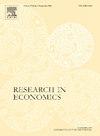Opaque payments, open wallets: The relationship between payment transparency and overspending
IF 1.2
Q3 ECONOMICS
引用次数: 0
Abstract
As payment methods evolve from cash to digital alternatives, their psychological and behavioural effects on spending behaviours, especially among young consumers, become increasingly important. Previous research has mainly compared credit cards and cash, showing that credit cards lead to more spending. However, the psychological mechanisms behind this are unclear due to differences in coupling time and transparency between the methods. This study bridges the gap by examining not just credit cards and cash, but also prepaid cards and cash, which have a similar coupling between consumption and payment but differ in transparency or payment format. By comparing prepaid cards with cash, the study explores whether the format of payment itself impacts spending behaviour. Drawing from a novel survey of Indonesian college students, this study presents empirical findings that credit card and prepaid card use (extensive margin) and payment frequency (intensive margin) are associated with overspending, whereas cash payments show no such association. The evidence suggests that payment transparency influences consumer behaviour, clarifying the underlying psychological mechanism of how payment methods affect spending. Further analysis shows that higher financial literacy helps mitigate the impact of less transparent payment methods on overspending. These insights suggest opportunities for developing digital payment solutions that minimize negative consequences, particularly for younger users. Educational initiatives tailored to promoting responsible digital payment usage could further reduce these effects.
不透明的支付,开放的钱包:支付透明度与超支之间的关系
随着支付方式从现金转向数字支付,它们对消费行为的心理和行为影响变得越来越重要,尤其是在年轻消费者中。以前的研究主要是比较信用卡和现金,表明信用卡导致更多的消费。然而,这背后的心理机制尚不清楚,由于耦合时间和透明度的方法之间的差异。这项研究不仅考察了信用卡和现金,还考察了预付卡和现金,弥补了这一差距。这两种方式在消费和支付之间有着相似的耦合关系,但在透明度或支付形式上有所不同。通过比较预付卡和现金,该研究探讨了支付方式本身是否会影响消费行为。根据对印尼大学生的一项新调查,本研究提出了实证研究结果,信用卡和预付卡的使用(广泛的边际)和支付频率(密集的边际)与超支有关,而现金支付则没有这种联系。证据表明,支付透明度影响消费者行为,阐明了支付方式如何影响消费的潜在心理机制。进一步的分析表明,更高的金融知识水平有助于减轻不透明的支付方式对超支的影响。这些见解为开发数字支付解决方案提供了机会,这些解决方案可以最大限度地减少负面影响,特别是对年轻用户。旨在促进负责任地使用数字支付的教育举措可以进一步减少这些影响。
本文章由计算机程序翻译,如有差异,请以英文原文为准。
求助全文
约1分钟内获得全文
求助全文
来源期刊

Research in Economics
ECONOMICS-
CiteScore
1.40
自引率
0.00%
发文量
37
审稿时长
89 days
期刊介绍:
Established in 1947, Research in Economics is one of the oldest general-interest economics journals in the world and the main one among those based in Italy. The purpose of the journal is to select original theoretical and empirical articles that will have high impact on the debate in the social sciences; since 1947, it has published important research contributions on a wide range of topics. A summary of our editorial policy is this: the editors make a preliminary assessment of whether the results of a paper, if correct, are worth publishing. If so one of the associate editors reviews the paper: from the reviewer we expect to learn if the paper is understandable and coherent and - within reasonable bounds - the results are correct. We believe that long lags in publication and multiple demands for revision simply slow scientific progress. Our goal is to provide you a definitive answer within one month of submission. We give the editors one week to judge the overall contribution and if acceptable send your paper to an associate editor. We expect the associate editor to provide a more detailed evaluation within three weeks so that the editors can make a final decision before the month expires. In the (rare) case of a revision we allow four months and in the case of conditional acceptance we allow two months to submit the final version. In both cases we expect a cover letter explaining how you met the requirements. For conditional acceptance the editors will verify that the requirements were met. In the case of revision the original associate editor will do so. If the revision cannot be at least conditionally accepted it is rejected: there is no second revision.
 求助内容:
求助内容: 应助结果提醒方式:
应助结果提醒方式:


